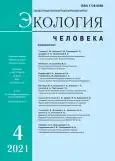INTELLIGENT DATA ANALYSIS IN BIOMEDICAL RESEARCH: ARTIFICIAL NEURAL NETWORKS
- Authors: Narkevich A.N.1, Vinogradov K.A.1, Paraskevopulo K.M.1, Grjibovski A.M.2,3,4,5
-
Affiliations:
- Voino-Yasenetsky Krasnoyarsk State Medical University
- Northern State Medical University
- West Kazakhstan Marat Ospanov Medical University
- Al-Farabi Kazakh National University
- M. K. Ammosov North-Eastern Federal University
- Issue: Vol 28, No 4 (2021)
- Pages: 55-64
- Section: Articles
- URL: https://journals.rcsi.science/1728-0869/article/view/70894
- DOI: https://doi.org/10.33396/1728-0869-2021-4-55-64
- ID: 70894
Cite item
Full Text
Abstract
Full Text
##article.viewOnOriginalSite##About the authors
A. N. Narkevich
Voino-Yasenetsky Krasnoyarsk State Medical University
Email: narkevichart@gmail.com
доктор медицинских наук, зав. лабораторией медицинской кибернетики и управления в здравоохранении, зав. кафедрой медицинской кибернетики и информатики, декан медико-психолого-фар-мацевтического факультета Красноярск
K. A. Vinogradov
Voino-Yasenetsky Krasnoyarsk State Medical UniversityКрасноярск
K. M. Paraskevopulo
Voino-Yasenetsky Krasnoyarsk State Medical UniversityКрасноярск
A. M. Grjibovski
Northern State Medical University; West Kazakhstan Marat Ospanov Medical University; Al-Farabi Kazakh National University; M. K. Ammosov North-Eastern Federal UniversityАрхангельск; г. Актобе, Казахстан; г. Алматы, Казахстан; г. Якутск
References
- Алексеева О. В., Россиев Д. А., Ильенкова Н. А. Применение искусственных нейронных сетей в дифференциальной диагностике рецидивирующего бронхита у детей // Сибирское медицинское обозрение. 2010. Т. 66, № 6. С. 75-79
- Богданова Ю. А., Зарипова Г. Р., Катаев В. А., Галимов О. В. Современные модели экспертных медицинских систем в прогнозировании операционного риска при наиболее распространенных интраабдоминальных вмешательствах (обзор) // Медицинский альманах. 2017. Т. 46, № 1. С. 9-12
- Выучейская М. В., Крайнова И. Н., Грибанов А. В. Нейросетевые технологии в диагностике заболеваний (обзор) // Журнал медико-биологических исследований. 2018. Т. 6, № 3. С. 284-294
- Горожанцев Ю. Н., Сергиенко С. Г., Воротынцева Е. А., Емельяненко Ю. В., Горожанцева А. В. Использование возможностей искусственных нейронных сетей при анализе записей холтеровского мониторирования // Инновационная медицина Кубани. 2018. Т. 9, № 1. С. 12-15
- Ершов А. В., Капсаргин Ф. П., Бережной А. Г., Мылтыгашев М. П. Экспертные системы в оценке данных урофлоуграмм // Вестник урологии. 2018. Т. 6, № 3. С. 12-16
- Калиниченко А. Н., Моторина С. В., Лагирвандзе А. К. Алгоритм анализа фибрилляции предсердий по ЭКГ на основе искусственной нейронной сети // Биотехносфера. 2019. Т. 64, № 6. С. 47-51
- Качан Т. В., Курочкин А. В., Головатая Е. А., Марченко Л. Н., Федулов А. С., Далидович А. А., Скрыпник О. В., Муштина Т. А. Роль искусственных нейронных сетей в выявлении ранней гибели ганглионарных клеток сетчатки у пациентов с дегенеративными оптиконейропатиями // Офтальмология. Восточная Европа. 2019. Т. 9, № 4. С. 446-456
- Лазаренко В. А., Зарубина Т. В., Антонов А. Е., Суд С. Опыт нейросетевого прогнозирования потребности в оперативном лечении у пациентов с заболеваниями гепатопанкреатодуоденальной зоны // Казанский медицинский журнал. 2018. Т. 99, № 4. С. 569-574
- Литвин А. А. Интеллектуальные системы поддержки принятия решений на основе искусственных нейронных сетей в неотложной панкреатологии (систематический обзор) // Гастроэнтерология Санкт-Петербурга. 2017. № 2. С. 28-33
- Наркевич А. Н., Виноградов К. А. Настольная книга автора медицинской диссертации: пособие. М., 2019. 454 с
- Banerjee I., Ling Y., Chen M. C., Hasan S. A., Langlotz C. P., Moradzadeh N. et al. Comparative effectiveness of convolutional neural network (CNN) and recurrent neural network (RNN) architectures for radiology text report classification. Artificial Intelligence in Medicine. 2019, (97), pp. 79-88. doi: 10.1016/j.artmed.2018.1 1.004.
- Cao C., Wang W, Jiang P. Clustering of self-organizing map identifies five distinct medulloblastoma subgroups. Cancer biomarker. 2016, 16 (3), pp. 327-332. DOI: 10.3233/ CBM-160570.
- Choi E., Schuetz A., Stewart W F., Sun J. Using recurrent neural network models for early detection of heart failure onset. Journal of the American Medical Informatics Association. 2017, 24 (2), pp. 361-370. DOI: 10.1093/ jamia/ocw112.
- Kvist T., Voutilainen A., Eneh V., Mantynen R., Vehvilainen-Julkunen K. The self-organizing map clustered registered nurses’ evaluations of their nurse leaders. Journal of Nursing Management. 2019, 27 (5), pp. 981-991. doi: 10.1111/jonm.12758.
- Lee J. G., Jun S., Cho Y. W, Lee H., Kim G. B., Seo J. B., Kim N. Deep Learning in Medical Imaging: General Overview. Korean Journal of Radiology. 2017, 18 (4), pp. 570-584. doi: 10.3348/kjr.2017.18.4.570.
- Lorencin I., Andelic N., Spanjol J., Car Z. Using multi-layer perceptron with Laplacian edge detector for bladder cancer diagnosis. Artificial Intelligence in Medicine. 2020, (2), e101746. doi: 10.1016/j.artmed.2019.101746.
- Makris G. M., Pouliakis A., Siristatidis C., Margari N., Terzakis E., Koureas N., Pergialiotis V., Papantoniou N., Karakitsos P. Image analysis and multi-layer perceptron artificial neural networks for the discrimination between benign and malignant endometrial lesions. Diagnostic Cytopathology. 2017, 45 (3), pp. 202-211. DOI: 10.1002/ dc.23649.
- Mendez K. M., Broadhurst D. I., Reinke S. N. The application of artificial neural networks in metabolomics: a historical perspective. Metabolomics. 2019, 15 (11), pp. 142. doi: 10.1007/s11306-019-1608-0.
- Rajeev R., Samath J. A., Karthikeyan N. K. An Intelligent Recurrent Neural Network with Long Short-Term Memory (LSTM) BASED Batch Normalization for Medical Image Denoising. Journal of Medical Systems. 2019, 43 (8), pp. 234. doi: 10.1007/s10916-019-1371-9.
- Sarigul M., Ozyildirim B. M., Avci M. Differential convolutional neural network. Neural Networks. 2019, (116), pp. 279-287. doi: 10.1016/j.neunet.2019.04.025.
- Savalia S., Emamian V. Cardiac Arrhythmia Classification by Multi-Layer Perceptron and Convolution Neural Networks. Bioengineering (Basel). 2018, 5 (2), pp. 35. DOI: 10.3390/ bioengineering5020035.
- Shahid N., Rappon T., Berta W Applications of artificial neural networks in health care organizational decision-making: A scoping review. PLoS One. 2019, 14 (2), e0212356. doi: 10.1371/journal.pone.0212356.eCollection 2019.
- Sherbet G. V, Woo W L., Dlay S. Application of Artificial Intelligence-based Technology in Cancer Management: A Commentary on the Deployment of Artificial Neural Networks. Anticancer Research. 2018, 38 (12), pp. 6607-6613. doi: 10.21873/anticanres.13027.
- Van Gassen S., Callebaut B., Van Helden M. J., Lambrecht B. N., Demeester P., Dhaene T., Saeys Y. FlowSOM: Using self-organizing maps for visualization and interpretation of cytometry data. Cytometry A. 2015, 87 (7), pp. 636-45. doi: 10.1002/cyto.a.22625.
- Yasaka K., Akai H., Kunimatsu A., Kiryu S., Abe O. Deep learning with convolutional neural network in radiology. Japanese Journal of Radiology. 2018, 36 (4), pp. 257-272. doi: 10.1007/s1 1604-018-0726-3.
Supplementary files







